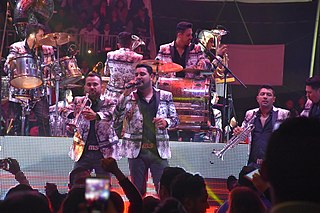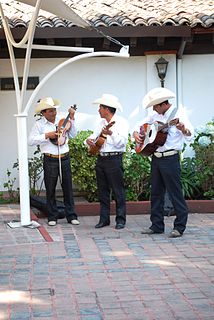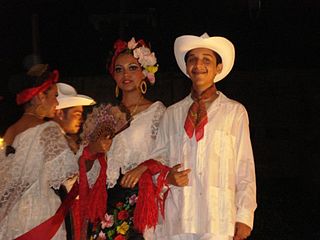 W
WBanda is a genre of Regional Mexican music and the musical ensemble in which wind instruments, mostly of brass and percussion, are performed.
 W
WChicano rock is rock music performed by Mexican American (Chicano) groups or music with themes derived from Chicano culture. Chicano Rock, to a great extent, does not refer to any single style or approach. Some of these groups do not sing in Spanish at all, or use many specific Latin instruments or sounds. The subgenre is defined by the ethnicity of its performers, and as a result covers a wide range of approaches.
 W
WThe corrido is a popular narrative metrical tale and poetry that forms a ballad. The songs are often about oppression, history, daily life for criminals, the vaquero lifestyle, and other socially relevant topics. Corridos were widely popular during the Mexican Revolutions of the 20th century, and in the Southwestern American frontier as it was also a part of the development of the New Mexico music style, where it later influenced Western music. The corrido derives largely from the romance, and in its most known form consists of a salutation from the singer and prologue to the story, the story itself, and a moral and farewell from the singer. It is still a popular genre today in Mexico.
 W
WGrupera is a genre of Regional Mexican music. It reached the height of its popularity in the 1990s, especially in rural areas. The music has roots in the rock groups of the 1960s, but today generally consists of four or more musicians using electric guitars, keyboards and drums. The music increased in popularity in the 1980s and became commercially viable, and is now recognized in some Latin music awards ceremonies such as Lo Nuestro and The Latin Grammy Awards. Grupero artists typically perform rancheras, corridos, cumbias, charangas, ballads, boleros and chilenas/huapangos.
 W
WHuapango is a family of Mexican music styles. The word likely derives from the Nahuatl word cuauhpanco that literally means 'on top of the wood', alluding to a wooden platform on which dancers perform zapateado dance steps. It is interpreted in different forms, the most common being the classic huapango interpreted by a trio of musicians ; the huapango norteño interpreted by a group ; and the huapango de mariachi, which can be performed by a large group of musicians.
 W
WThe jarabe is one of the most traditional song forms of the mariachi genre. In the Spanish language, jarabe literally means syrup, which probably refers to the mixture of meters within one jarabe.
 W
WA jarocho is a person, item or style of music from the city of Veracruz, Mexico.
 W
WMariachi is a genre of regional Mexican music that dates back to at least the 18th century, evolving over time in the countryside of various regions of western Mexico. The usual mariachi group today consists of as many as eight violins, two trumpets and at least one guitar, including a high-pitched vihuela and an acoustic bass guitar called a guitarrón, and all players taking turns singing lead and doing backup vocals.
 W
WMexican cumbia is a type of cumbia, a music which originated in Colombia but was reinvented and adapted in Mexico.
 W
WNew Mexico music is a genre of music that originated in the US State of New Mexico, it derives from the Pueblo music in the 13th century, and with the folk music of Hispanos during the 16th to 19th centuries in Santa Fe de Nuevo México. The style went through several changes during pre-statehood, mostly during the developments of Mexican folk and cowboy Western music.
 W
WNorteño or Norteña, also música norteña, is a genre of Regional Mexican music. The music is most often based on duple and triple metre and its lyrics often deal with socially relevant topics, although there are also many norteño love songs. The accordion and the bajo sexto are traditional norteño's most characteristic instruments. Norteña music developed in the late 19th century, as a mixture between local Mexican music and Austrian-Czech-origin folk music.
 W
WMexican rock music, often referred to in Mexico as rock nacional, originated in the 1950s. Standards by The Beatles, Elvis Presley, The Everly Brothers, Nancy Sinatra and Chuck Berry, were soon covered by bands such as Los Apson, Los Teen Tops, Los Twisters, Los Hitters, Los Nómadas, Los Rockets, Los Rebeldes del Rock, Los Locos del Ritmo, Los Crazy Boys, and Javier Bátiz, which later led to original compositions, often in English. The group "Los Nómadas" was the first racially integrated band of the 1950s. Their lead guitarist, Bill Aken, wrote most of their original material, including the raucous Donde-Donde, and co-wrote the material for their Sounds Of The Barrio album, which is still being sold. Their 1954 recording of She's My Babe was the first top 40 R&B recording by a Latino band. In the southwestern United States, Spanish guitar rhythms and Mexican musical influences may have inspired some of the music of American musicians Ritchie Valens, Danny Flores, Sam the Sham, Roy Orbison and later, Herb Alpert. Initially, the public exhibited only moderate interest in them, because the media attention was focused on La Ola Inglesa.
 W
WThe son calentano is an instrumental form of music from the Tierra Caliente region, Mexico. It has meters in 3/4 and 6/8, an ornamented use of violin and back beats on guitar and tamborita. It is usually played by conjunto calentano ensembles and is traditionally performed with dancers.
 W
WSon huasteco is one of eight Mexican song styles and is a traditional Mexican musical style originating in the six state area of Northeastern Mexico called La Huasteca. It dates back to the end of the 19th century and is influenced by Spanish and indigenous cultures. Usually it is played by a Trio Huasteco composed of a guitarra quinta huapanguera a Jarana huasteca and a violin. Singers will often use the falsetto register. The son huasteco is particularly noteworthy for its flamboyant and virtuoso violin parts, although the style varies from state to state. Footwork often danced to son huasteco is the Zapateado. Improvisation plays a strong role in the style, with musicians creating their own lyrics and arrangements to a standard repertoire. Typical sones huastecos are "Cielito lindo", "La huazanga", "La sirena", "El querreque" and "La cigarra".
 W
WSon mexicano is a style of Mexican folk music and dance that encompasses various regional genres, all of which are called son. The term son literally means "sound" in Spanish, and is also applied to other unrelated genres, most notably son cubano.